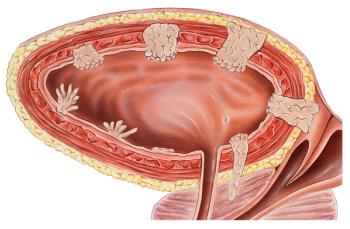
Venetoclax Schedule Modifications Linked to Longer OS in Real-World Newly Diagnosed AML
Patients with newly diagnosed acute myeloid leukemia had longer overall survival with a modified dosing schedule of venetoclax plus a hypomethylating agent.
Real-world data suggest addressing and treating newly diagnosed acute myeloid leukemia (AML) with venetoclax (Venclexta) plus hypomethylating agents requires appropriate toxicity management, including dosing and schedule modifications, according to a study published in The Oncologist.
Among patients with newly diagnosed AML who received treatment for a median of 5.2 months, the median overall survival (OS) was 8.6 months (95% CI, 7.7-11.1). Patients who had received prior hypomethylating agents (n = 20) had a shorter median OS of 3.8 months (95% CI, 1.8-10.0) compared with those who had no recorded prior use (n = 55) at 12.6 months (95% CI, 5.4-not reached [NR]; log-rank P = .0018). Schedule modifications, which occurred in 101 patients, resulted in longer median OS of 10.4 months (95% CI, 8.2-15.7) compared with no modifications at 7.7 months (95% CI, 4.4-11.1; P = .02). In the 56 patients with dose changes, numerically longer median OS occurred at 10.0 months (95% CI, 7.0-NR) vs 8.4 months (95% CI, 7.1-12.7) in patients without dose changes, but this was not significant .
A total of 169 patients were analyzed, with demographics being well balanced between groups. Amongst all comers, 60.9% of patients received venetoclax plus azacitidine and the remainder (39.1%) received venetoclax plus decitabine. The median follow-up was 7.2 months in across all patients, 4.6 months in the nonresponse sub-cohort, and 3.7 months in the blast clearance unevaluable sub-cohort.
At the end of follow-up, 55.6% of patients had died, and 10.1% had died within 60 days of first-line treatment initiation. In the blast clearance unevaluable sub-cohort, 18.9% of patients died within 60 days of first-line treatment initiation compared with less than 4.2% of those with documented bone marrow biopsy. In less than 2.4% of patients, death occurred within 30 days of treatment.
After day 7 of the post-ramp-up dose, 49.1% of patients receiving 400 mg of venetoclax, 3.0% received 300 mg, 19.5% receiving 200 mg, and 20.1% receiving 100 mg or less, while 8.3% had no dosing recorded. The dose intensity, defined as the proportion of days with venetoclax dosing from the start to the end of treatment, was 67.8% and 33.1% of patients had changes to the venetoclax dose following the dose ramp-up.
Of note, 88.2% of patients began with a 28-day dosing schedule of venetoclax, with the rest beginning with either 21- or 14-day schedules save for 6 patients who had unknown information. In 73.8% of patients, there was no schedule deviation, but 43.6% of these patients received 60 or fewer days of therapy. Schedule modifications occurred in 59.8% of patients, with a median time to first changes of 33 days (95% CI, 28-52) mostly occurring between 1 and 2 treatment cycles.
Investigators reported that 26.2% of patients converted to a cycle of 21 days or fewer for 2 consecutive cycles, 16.1% switched from a 28- to a 21-day schedule, and 8.7% switched to a 14-day cycle. Discontinuation of venetoclax occurred in 52.7% of patients. Dose changes occurred in 25% of patients due to drug-drug interactions, with 62.5% of patients not reporting a reason for the change.
The bone marrow biopsy for blast-evaluable data was available in 95 patients, with 53.7% of patients having a sample by day 28 (±14), with most (80.4%) achieving a response. Correlation between bone marrow assessment and lower change in blast count from baseline were noted, with 85.3% of patients with evaluation within 30 days of diagnosis, 61.1% with evaluation within 30 to 60 days, and 50.0% with evaluation within 60 to 90 days being responders. In 82.1% of patients with bone marrow blast-evaluable data, which was available any time during follow-up, had a response.
Grade 3/4 treatment-emergent cytopenias were observed in 48 patients with complete laboratory data available at baseline and follow-up. At a median of 8 days (95% CI, 6-15), 44 patients had an event after the start of therapy, most of which (n = 39) occurred within 60 days of initiation.
Reference
Vachhani P, Flahavan EM, Xu T, et al. Venetoclax and hypomethylating agents as first-line treatment in newly diagnosed patients with AML in a predominately community setting in the US. Oncologist. Published Online August 4, 2022. doi:10.1093/oncolo/oyac135
Newsletter
Stay up to date on recent advances in the multidisciplinary approach to cancer.


























































































